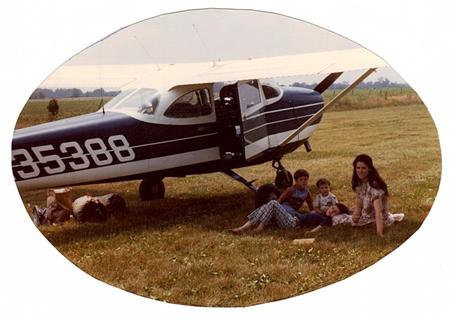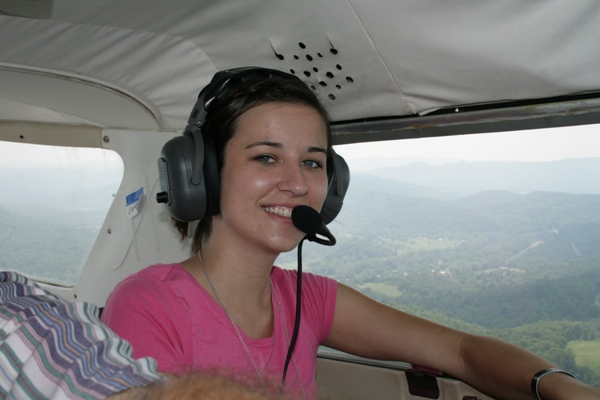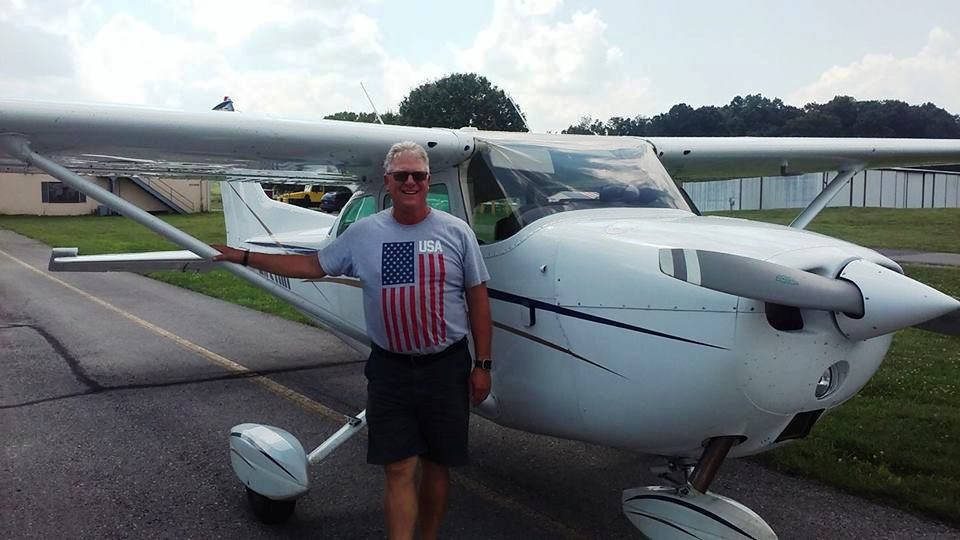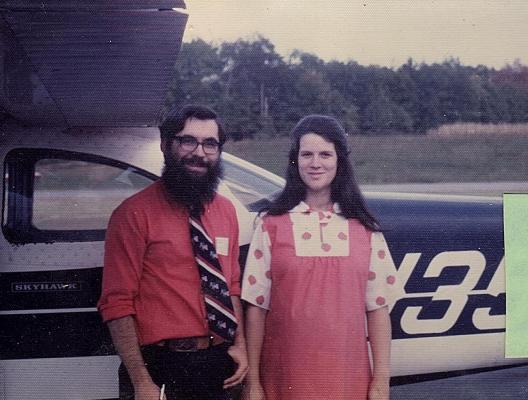Eagles' Wings Flight Training
Serving the Beautiful Greenbrier Valley of West Virginia since 1984
Serving the Beautiful Greenbrier Valley of West Virginia since 1984
Flying has been called “the ultimate freedom” by many people, and it is of course one of the most “fun” things a person can do. But unfortunately, it has never had the reputation of being “cheap.” In 1909, the Wright Brothers sold an airplane to the U.S. Army for $25,000, (plus a $5,000 bonus because it exceeded the basic speed requirement). You can sometimes buy a much better airplane (used) today for that price, with equipment and performance the Wrights never dreamed of!
But you don’t need $25,000 to begin flying. Most flight schools offer some kind of an Introductory Flight for $100 or so, maybe even less. When I learned to fly in the 1970s, I spent about $1300 to obtain a Private Pilot’s License, and had about 60 hours of flight time when I took my flight test. It would be great if you could still learn to fly at that price, but you are probably not working for the wages we did then. One of my recent flight students told me it has actually cost him about $5,000 get his Private Pilot’s License.
By today’s standards, $6000 - $8000 is not an outrageous price for an educational experience which is not only fun, but also a very useful life-time investment. In many places $10,000 or 12,000 might be the norm, but that isn't so bad for a lifetime investment in modern aircraft utilizing modern radio and navigation technology.
My basic rate for flight instruction in a Cessna 150 is $125 per hour, plus $400 per year for insurance. This includes the airplane, gas, insurance, and the instruction. After you begin flying solo, some rates are reduced somewhat.
Although being the “cheapest” is not my primary goal, I do believe my hourly rates are about as low of price you will find these days.
Flying is partly knowledge, partly skill, and partly judgment. Some times throughout your training you can expect to pay for some “ground time” which means personalized instructional time to assure you have the knowledge required for solo flight, cross-country flight planning, the FAA Knowledge Test, and the final Practical Test.
Other times, when there is enough interest, I conduct a Private Pilot Ground School, which can save you time and money. It also give you the opportunity to interact with others who are learning to fly.
For decades flight instructors were faced with the dilemma of making enough money to stay in business – people thought they shouldn’t get paid except when actually flying. All other teachers do ALL their teaching on the ground, and get paid. Flight instructors have to have a Federal license, it has to be renewed every two years, and they can be called in question for any student or former student who was not taught properly. Public schools fight the idea of “merit pay,” but flight instructors are required to maintain certain performance and knowledge standards.
A flight instructor usually spends about 2 hours with the student for every hour for which he gets paid. In more recent decades we have succeeded in demonstrating to the flying community that instructors must be reimbursed for their time – just like other workers “putting their time in.”
As of March 20, 2025, our flight instruction rates will be:
Dual instruction in my airplane ….......…..$140. per hourNormally, on a first lesson we fly from Lewisburg to Beckley and back. The student goes through the start, taxi, take-off, straight and level, and landing sequence twice. This makes a good flight experience, crossing the New River Gorge, and takes about 1.4 hours of flying time, plus $10 for a log book, and a $15 insurance surcharge. The total cost is $187.50 or $200, depending on the exact length of the flight. If you need a shorter lesson, don’t be afraid to ask.
Most flight lessons are 1.2 to 1.3 hour. Some of my students drive pretty far to get here, so they like longer lessons, but you need a little time to digest new experiences between lessons, so the idea of flying long flights twice a day, does not work out very well in the long run.


One our your best budget-conscious investments is to join the AOPA or the EAA, or both. Both of these organizations are very committed to the promotion and defense of "grass roots" people like you and me. In both organizations, Membership includes a subscription to beautiful monthly magazine, sometimes a choice of several. Both organizations are actively involved in government advocacy, your freedom to fly. You will definitely get your money's worth by joining these organizations.
To learn to fly in the most expeditious and economical manner, you must give it a reasonably high priority of your time and money for a while. A guy whose family had money, once said to me, “There is nothing I’d rather do than fly,” but he had not flown for several years. Obviously, there were many things he was choosing to do, rather than to fly. If you want to fly, but every time the weather is good you go fishing or golfing, you might never achieve your higher goal.
It usually takes about 60 hours of training and experience to get a Private Pilot’s License. Only 20 hours are required to be with a certified instructor, and you must have at least 10 hours of solo time. Some people seem to think they can save money by keeping their solo time to the minimum. I believe in most cases this means they will end up paying for more DUAL instruction, which cost more. Why not plan on 30 hours of dual, and 30 hours of solo time right from the start? Make you solo time count on your knowledge, skills, judgment, and mastery of concepts and procedures. This could save significantly over having only 15 hours of solo time and 45 hours of dual.
You will also save money on ground time and preparation for tests if you have developed good study habits, and are able to learn well on your own. If you have not learned good study habits, you can still do so. It will save you money, and make you into a better informed, and safer pilot.
When I learned to fly, and even later as an instructor, applicants were required to have at least 20 hours of solo time, and that did not seem excessive. A later change in regulations gives us some flexibility we didn’t have before, but it does not diminish the time it takes to learn. In some ways the flight rules, airspace, the equipment, and procedures are more complex than before. Utilizing your training time wisely, including use of your solo flight time, and personal study time, will be a great benefit to you.
Usually, it does NOT save money to buy your own airplane before you get your license. There might be exceptions in aviation oriented families. You certainly don’t want any long delays and unpleasant expenses related to maintenance on a “cheap” airplane.
After earning your pilot’s license, some people continue to fly by simply renting the airplane they have been flying. Others join flying clubs which are often a sort of joint ownership. Some of course buy an airplane of their own. A joint ownership with 2 to 6 partners is often a workable option.
There is a natural tendency to want to move up to bigger and fasters airplanes. However, many people have forced themselves out of flying by investing in more airplane than they were ready for, financially or otherwise.
Inexpensive flying is still flying. If you think you have to have access to the latest $750,000 airplane, you will price yourself out of the air, and go through the rest of your life always talking about how expensive it was. Flying a $25,000 airplane may be a lot more enjoyable, and valuable, than NOT flying a more expensive one.
I was a Private Pilot for six years before becoming a flight instructor, and I became living proof that you don’t have to be very “well off” to fly at least frequently. I was able to rent an airplane and take my family on multiple family trips – each trip about the price most people were paying for one car payment. Over a period of time, most people spend quite a bit of money on motor vehicles, pleasure, entertainment, vacations, etc. A portion taken from each of these budgets can help you afford to fly on a regular basis.
Many people are spending in excess of $30,000 for a motor vehicle - even $70,000 for a fancy pickup truck. Since they are usually financing through a bank, they have to have comprehensive insurance. Those two major expenses do not transport you anywhere – that’s just to have the car or truck.
I am not telling you should not have a nice car, but demonstrating the math, that flying is probably within your budget. Keep it simple, and you can enjoy a long flying career.
* The Cream of the Crop flight training manual is produced by an old company called Jeppesen, and called “Private Pilot Guided Flight Discovery.” The manual is the most comprehensive and colorful, but may cost about $75.-$85. Shop around online. The whole kit of Supplies from Jeppesen can probably be found for about $200. Google: Jeppesen Guided Flight Discovery, part 61.
Another excellent, but less colorful manual is from ASA, called Complete Private Pilot (about $20), and a complete kits with it can be obtained for about $100. Either the Jeppesen or the ASA kits include some other training materials such as Federal Aviation Regulations (FAR), Aeronautical Information Manual (AIM), Airmens Certification Standards (ACS), and other test preparation guides, manual flight computers, and gadgets. Most of my Private Pilot Ground School classes have centered on this textbook.
The most popular video kits are from Sporty’s Pilot Shop (beginning at $200), and King’s Ground School. I haven’t seen all their latest materials, but normally prefer Sporty’s. Both Sporty’s and King’s have great variety of merchandise, but don’t spend all your money on accessories or you’ll never get off the ground!
The FAA standard textbook “The Pilot’s Handbook of Aeronautical Knowledge” is very complete and colorful and available FREE online at:
I am having trouble getting this link to work. But you could use the visibile words as Google search.
It is a government publication, is public domain, so other publishers offer it in the printed format for reasonable prices. I still prefer to have most of my reading material in printed form, but with all the use of smart phones, computers, software, apps, and tablets, the options are limitless.
One of my desires when I learned to fly was to be able to fly on family trips, and we lived that dream for several years. Our first family trip was to Jamestown, Tennessee the day after Christmas in 1978. Our son Benji was one month old.

The picture above is of our children waiting under the airplane wing in the sweltering heat of western Illinois in 1980. Our distant cousin, Francis Craig Hersman (Uncle Rusty, 1885-1987), who was 95 at the time, picked us up at the little grass airport near Mt. Sterling - which is adjacent to Hersman, Illinois.
Pictured above, are several airplanes at the Annual Picnic at Hinton-Alderson Airport, Pence Springs, West Virginia. September 2016. The event has become more of a Wings and Wheels Festival, and is on the Third Saturday of September.

This is our niece, Tiffany, who came and flew with me one summer. She soloed in a few weeks. Many people put off taking flying lessons, hoping they will have more money later. Some "professionals" say to wait until you have enough money for the whole deal before you start, but the fact is many thousands of us just paid for one lesson at a time, became instructors, or other commerical pilots of all levels. Ask yourself? When will you be likely to have $6000 - $10,000 extra to pay for flying lessons? That's fine if you do, but don't let it deter you from the joy of flying if you have to "pay as you go!"
Here is an inexpensive airplane, a Cessna 120, sort of the grandfather of many later Cessna family members. Many professionals and airline pilots still get their flying pleasure from access to some inexpensive little "taildragger" like this. Prices vary and fluctuate, but often you can get an airplane similar to this for about $20,000. (2023 price are up somewhat.) With reasonable maintenance, you would probably be able to sell it later for at least what you paid for it. So the net cost of flying is not that high.

There is a reason why the Cessna 172 is the most plentiful civilian aircraft ever produced, why it has stood the test of time. Nobody can claim which airplane is absolutely the BEST, because each one was designed for a particular purpose. But the Cessna 172, has proven itself to be one of the best all-around champions, with very good performance at a moderate price. There have been a few varibles of it, but you can usually plan on about 120 mph (105 kts) and can carry enough fuel to take four moerately sized people on a trip lasting up to 3.8 hours. This one is owned by a long-enduring pilot's club, so each member owns one-sixth of the airplane, and they all share the fixed costs. It has worked out good for them for several decades. Here again is Rudy Swatzyna after his first solo flights. There are two other Cessna 172s on this page.

Crystal and I are pictured here, on our ninth Anniversary (1978). We had flown down to Mt. Airy, North Carolina, after school, had a light meal at the Good News Cafe', and flew back in time for Wednesday evening prayer meeting. For years, until our family outgrew it, we did a lot of our family travel in rented airplanes. For a while I had access to a Hawk XP which was like a Cessna 172 with 195 horsepower. We could rent a standard 172 for a 10 or 12 -hour trip, for about the price most people were paying for a monthly car payment. Our travel budget, including 2 or 3 flights like this per year was a lot less than many people were spending to stay on the ground, and only dream about flying. A family of up to four people can still do this. Six-seat planes are not as plentiful.